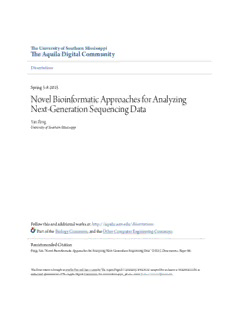
Novel Bioinformatic Approaches for Analyzing Next-Generation Sequencing Data PDF
Preview Novel Bioinformatic Approaches for Analyzing Next-Generation Sequencing Data
TThhee UUnniivveerrssiittyy ooff SSoouutthheerrnn MMiissssiissssiippppii TThhee AAqquuiillaa DDiiggiittaall CCoommmmuunniittyy Dissertations Spring 5-1-2015 NNoovveell BBiiooiinnffoorrmmaattiicc AApppprrooaacchheess ffoorr AAnnaallyyzziinngg NNeexxtt--GGeenneerraattiioonn SSeeqquueenncciinngg DDaattaa Yan Peng University of Southern Mississippi Follow this and additional works at: https://aquila.usm.edu/dissertations Part of the Biology Commons, and the Other Computer Engineering Commons RReeccoommmmeennddeedd CCiittaattiioonn Peng, Yan, "Novel Bioinformatic Approaches for Analyzing Next-Generation Sequencing Data" (2015). Dissertations. 88. https://aquila.usm.edu/dissertations/88 This Dissertation is brought to you for free and open access by The Aquila Digital Community. It has been accepted for inclusion in Dissertations by an authorized administrator of The Aquila Digital Community. For more information, please contact [email protected]. The University of Southern Mississippi NOVEL BIOINFORMATIC APPROACHES FOR ANALYZING NEXT-GENERATION SEQUENCING DATA by Yan Peng Abstract of a Dissertation Submitted to the Graduate School of The University of Southern Mississippi in Partial Fulfillment of the Requirements for the Degree of Doctor of Philosophy May 2015 ABSTRACT NOVEL BIOINFORMATIC APPROACHES FOR ANALYZING NEXT-GENERATION SEQUENCING DATA by Yan Peng May 2015 In general, DNA reconstruction is deemed as the key of molecular biology since it makes people realize how genotype affects phenotypes. The DNA sequencing technology emerged exactly towards this and has greatly promoted molecular biology’s development. The traditional method, “Sanger,” is effective but extremely expensive on a cost-per-base basis. This shortcoming of Sanger method leads to the rapid development of next-generation sequencing technologies. The NGS technologies are widely used by virtue of their low-cost, high-throughput, and fast nature. However, they still face major drawbacks such as huge amounts of data as well as relatively short read length compared with traditional methods. The scope of the research mainly focuses upon a quick preliminary analysis of NGS data, identification of genome-wide structural variations (SVs), and microRNA prediction. In terms of preliminary NGS data analysis, the author developed a toolkit named “SeqAssist” to evaluate genomic library coverage and estimate the redundancy between different sequencing runs. Regarding the genome-wide SV detection, a one-stop pipeline was proposed to identify SVs, which integrates the components of preprocessing, alignment, SV detection, breakpoints revision, and annotation. This pipeline not only detects SVs at the individual sample level, but also identifies consensus SVs ii at the population and cross-population levels. At last, miRDisc, a pipeline for microRNA discovery, was developed for the identification of three categories of miRNAs, i.e., known, conserved, and novel microRNAs. iii COPYRIGHT BY YAN PENG 2015 The University of Southern Mississippi NOVEL BIOINFORMATIC APPROACHES FOR ANALYZING NEXT-GENERATION SEQUENCING DATA by Yan Peng A Dissertation Submitted to the Graduate School of The University of Southern Mississippi in Partial Fulfillment of the Requirements for the Degree of Doctor of Philosophy Approved: _Dr. Nan Wang___________________ Committee Chair _Dr. Chaoyang Zhang______________ _Dr. Ping Gong___________________ _Dr. Chenhua Zhang_______________ _Dr. Zheng Wang__________________ _Dr. Karen S. Coats________________ Dean of the Graduate School May 2015 ACKNOWLEDGMENTS This is a great opportunity to express the immense gratitude to Dr. Nan Wang, Dr. Ping Gong, and all the other committee including, Dr. Chaoyang Zhang, Dr. Chenhua Zhang, and Dr. Zheng Wang, for their invaluable advice on my research as well as the dissertation. I gratefully acknowledge my co-advisors, Drs. Nan Wang and Ping Gong, for their generous help and continuous support in the past four years. Throughout my Ph.D program, they have been kindly, offering me her guidance, suggestions, and support. Special thanks that words cannot carry to my parents for giving birth to me in the first place and for their unconditional support throughout my life. Also, I would like to express much appreciation to my beloved husband, Dr. Jianan Wang, who has always been my support through the good times and bad. Thanks also go to all my co-workers at the Computational Biology and Bioinformatics Lab (CBBL), especially Lijuan Yang and Andrew Maxwell, for their help throughout my four year study. iv TABLE OF CONTENTS ABSTRACT .......................................................................................................... ii ACKNOWLEDGMENTS ....................................................................................... iv LIST OF TABLES ................................................................................................ vii LIST OF ILLUSTRATIONS ................................................................................... ix CHAPTER I. INTRODUCTION ............................................................................. 1 DNA Sequencing Technologies NGS Technologies Comparison NGS Sequence Analysis NGS Limitation Dissertation Organization II. SEQASSIST: A NOVEL TOOLKIT FOR PRELIMINARY ANALYSIS OF NEXT-GENERATION SEQUENCE DATA ............................... 15 Motivation Current Method SeqAssist Toolkit Pipeline Testing III. SVDISC: A NOVEL AND INTEGRATIVE PIPELINE FOR STRUCTURAL VARIANTS DISCOVERY USING GENOME RE-SEQUENCING DATA .............................................................. 37 Introduction Alignment Methods: BWA and MOSAIK Structural Variation Detection Methods: Pindel, BreakDancer, and CNVnator SVDisc Pipeline IV. MIRDISC: A NOVEL COMPUTATIONAL PROGRAM FOR MICRORNA DISCOVERY FROM SHORT DEEP SEQUENCING READS .......................................................................................... 57 Introduction Current Methods v miRDisc Package V. NGS DATA ANALYSIS: CASE STUDY ......................................... 69 Data Analysis Using SeqAssist microRNA Detection Using miRDisc VI. CONCLUSIONS .......................................................................... 132 Summary and Conclusions Future Work REFERENCES ................................................................................................. 134 vi LIST OF TABLES Table 1. Comparison of Next-generation Sequencing Method ................................ 7 2. Depth of Sequencing Data from MiSeq.................................................... 18 3. SAM Format ............................................................................................. 23 4. SA_RunStats Testing Result ................................................................... 31 5. Length and Coverage Breadth of 100 Synthetic reads (10 chr *10 unique reads) ........................................................................................... 32 6. SA_Run2Ref Testing Result .................................................................... 34 7. SA_Run2Run Testing Result ................................................................... 35 8. Different BLAST Programs ...................................................................... 55 9. Basic Information for All Testing Population ............................................ 71 10. Daphnia pulex Population and Samples .................................................. 76 11. Daphnia pulex Sequence Runs ............................................................... 77 12. Summary of Preprocessing Result for Different Population ..................... 79 13. Basic Statistics Produced by SA_Run2Ref for Two Sequencing Run Datasets ......................................................................................... 104 14. Sequencing Datasets and Genome Mapping of the Daphnia pulex TCO Library ........................................................................................... 106 15. Result of miRDeep2, miRExpress, sRNAbench, and miRDisc for C.elegans with miRBase v14 ................................................................. 118 16. Result of miRDeep2, miRExpress, sRNAbench, and miRDisc for C.elegans with miRBase v20 ................................................................. 119 17. Grouped Results of Candidate MicroRNA for C.elegans with miRBase v14 ........................................................................................ 121 vii
Description: